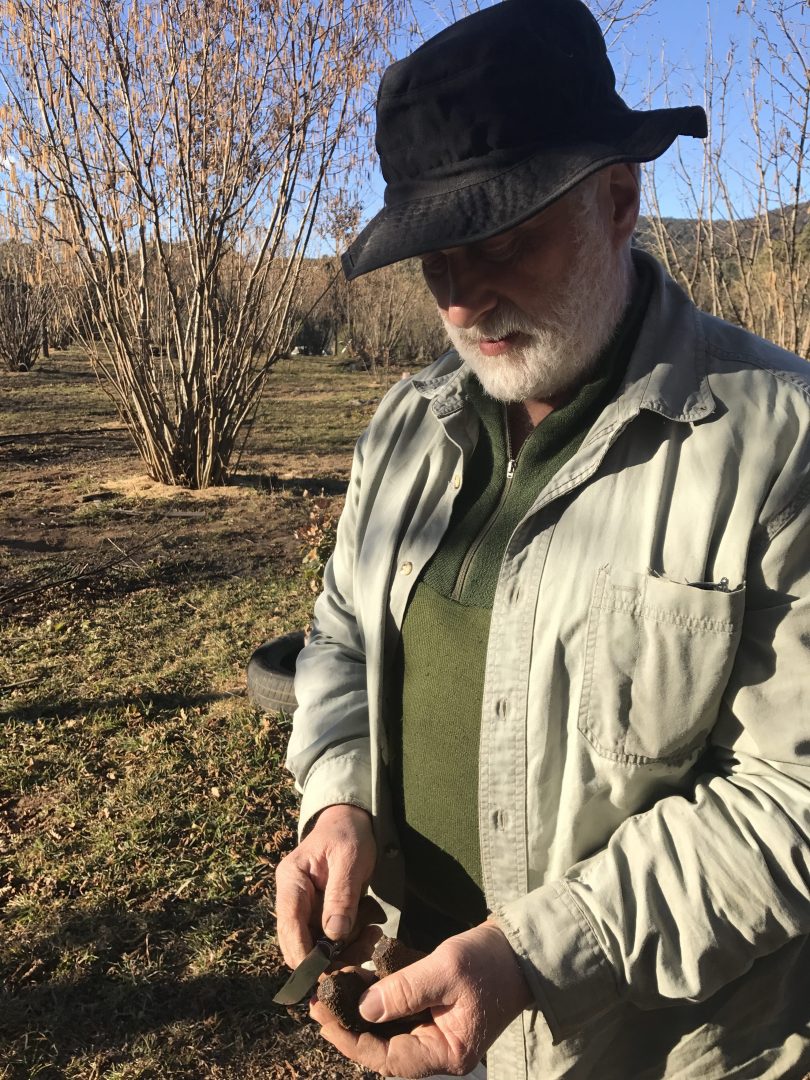
Terra Preta silviculturist and truffle grower Peter Marshall believes deciduous forest saved his truffiere. Photo: Genevieve Jacobs.
Peter Marshall has never been afraid to stir the pot. He reckons that decades of experience as a silviculturist, some impeccable qualifications in forestry and a globally successful truffle-growing operation back him up pretty solidly.
Peter has long argued that a focus on exclusively native planting is misguided: he goes as far as to call it a “nativist pogrom”, and he says that when the Currowan fire hit his property Terra Preta, near Braidwood, the proof was in the fire’s behaviour.
There was plenty at stake: Terra Preta is one of the most productive truffle operations in Australia, exporting over 300 kg of high-quality black truffles annually to chefs in Paris, New York, Los Angeles and Tokyo from the shadow of the Monga Forest.
For decades, Peter has planted a mosaic of trees including his truffle bearing hazelnuts and oaks, but also poplars and willows, and up to 30 bamboo varieties. His aim is to restore the property’s capacity to retain water at all levels, moving it gently through the soil profile rather than streaming off degraded, heavily compacted land.
Peter takes up the story via email: “For months we had been working ourselves silly to get Reidsdale Valley ready, cutting access to Monga Park and shifting fuel away from the forest edge. The Currowan Fire came screaming at us out of Monga forest [creating] feelings of imminent doom. I thought we would lose everything.”
But what happened next surprised everyone, including the local firefighters.
“It hit the bladed lines then the oaks plantation, dropped from crown to ground and went silent. Then out,” Peter says.
“Experienced firefighters were speechless with amazement, then swung into their trucks and headed for the next crucial point. Our deciduous forest released firefighting resources to operate at critical points elsewhere.”
Peter’s reasoning is that even a fire roaring uphill with a good draft will pause when it hits green trees. He estimates that a mature poplar, for example, is carrying 100 to 200 kg of water. As the fire and the trees interact, there’s a burst of flash evaporation from the greenery that absorbs heat. Peter says updraft wind will drop almost instantly under those conditions.
The wind controlling effect of banked deciduous foliage also worked to dramatically slow the fire’s spread and, three rows in, the blaze became controllable with groundwork and shovels.
“Trees [were] exploding and falling up in the eucalypts for days. A4 [-sized] chunks of burning bark [were] falling on us. Nearly all were self-extinguished by the boundary layer, the rest we swatted. Pretty work at night,” Peter says.
The irony for Peter is that his poplars began as rooted cuttings from trees marked for destruction when the ACT Government determined the species were weeds.
“A designed fire retardant landscape worked as planned. Silvicultural decisions made 30 years ago and exotic tree genetics we saved from the nativist pogroms saved our valley. I am amazed, too.
“Our native forest on Ironstone Hill … was saved from the fire by the bands of deciduous trees. It is now full of wildlife seeking refuge.”
Peter is a firm believer that the “native good, exotic bad” message has got out of hand among land-carers.
He’s deeply critical of what he describes as a belief that willows, poplars and oaks are invasive weeds, arguing that “random mixes of ‘natives’, many from a thousand kilometres away, have no silvicultural logic”, and describing wide belts of native planting running east-west as “frightening fire wicks, threatening to outflank firefighters at any time”.
At Terra Preta, the use of non-inversion tillage techniques has restored the soil’s ability to hold water, while biochar produced from coppiced biomass restores the soil’s fungal communities.
Peter points out that in pre-European times, these relationships were nurtured by massive numbers of now-extinct small marsupials, from bettongs to woylies and potoroos who trawled the forest floor looking for native truffle species and churning over soil and mulch. Forest floors were constantly damp and continually composting as a consequence.
He’s arguing for a “war footing” effort to eliminate feral predators, reintroduce native burrowers, thin out crowded forests and enrich forest floors.
“The situation is dire,” Peter says in reference to our degraded and water-resistant landscapes.
“We don’t have another 20 years to waste on discredited ideology. Native or exotic trees, my family will use every tool available to protect our land.”












